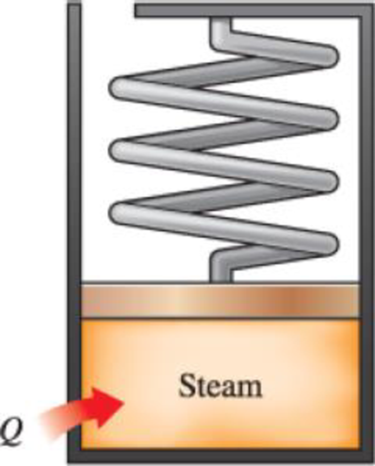
Concept explainers
Steam at 75 kPa and 8 percent quality is contained in a spring-loaded piston–cylinder device, as shown in Fig. P4–40, with an initial volume of 2 m3. Steam is now heated until its volume is 5 m3 and its pressure is 225 kPa. Determine the heat transferred to and the work produced by the steam during this process.
FIGURE P4–40

The heat transfer of the spring-loaded piston cylinder device.
The work done of the spring-loaded piston cylinder device.
Answer to Problem 39P
The heat transfer of the spring-loaded piston cylinder device is
The work done of the spring-loaded piston cylinder device is
Explanation of Solution
Write the expression for the energy balance equation.
Here, the total energy entering the system is
Substitute
Here, the mass of the piston cylinder device is
Calculate the specific volume of the spring-loaded piston cylinder device.
Here, the specific volume of saturated liquid is
Calculate the specific internal energy of the spring-loaded piston cylinder device.
Here, the specific internal energy of saturated liquid is
Write the expression for the mass of the system.
Here, the initial volume of the system is
Determine the final specific volume of the piston cylinder device.
The final volume of the piston cylinder device is
Determine the work done during the constant pressure process.
Here, the initial pressure is
Conclusion:
From the Table A-5, to obtain the value of the specific volume of saturated liquid is
Substitute 0.08 for
Substitute 0.08 for
Substitute
Substitute
From the Table A-5, to obtain the value of the specific volume of saturated liquid is
Determine the quality of final state for the spring-loaded piston-cylinder device.
Here, the specific volume of saturated liquid is
Substitute
Substitute 0.561375 for
Substitute
Thus, the heat transfer of the spring-loaded piston cylinder device is
Substitute
Thus, the work done of the spring-loaded piston cylinder device is
Want to see more full solutions like this?
Chapter 4 Solutions
EBK THERMODYNAMICS: AN ENGINEERING APPR
- Solve this problem and show all of the workarrow_forwardSolve this problem and show all of the workarrow_forwarddraw the pneumatic circuit to operate a double-acting cylinder with: 1. Extension: Any of two manual conditions plus cylinder fully retracted, → Extension has both meter-in and meter-out, 2. Retraction: one manual conditions plus cylinder fully extended, → Retraction is very fast using quick exhaust valve.arrow_forward
- Correct answer is written below. Detailed and complete solution with fbd only. I will upvote, thank you. Expert solution plsarrow_forwardCorrect answer is written below. Detailed and complete solution with fbd only. I will upvote, thank you.arrow_forwardCorrect answer is written below. Detailed and complete solution with fbd only. I will upvote, thank you.arrow_forward
- Correct answer is written below. Detailed and complete solution only with fbd. I will upvote, thank you.arrow_forwardCorrect answer is written below. Detailed and complete solution only. I will upvote, thank you.arrow_forwardCorrect answer is written below. Detailed and complete solution with fbd only. I will upvote, thank you.arrow_forward
- Correct answer is written below. Detailed and complete solution only. I will upvote, thank you.arrow_forwardCorrect answer is written below. Detailed and complete solution with fbd only. I will upvote, thank you.arrow_forwardCorrect answer is written below. Detailed and complete solution only. I will upvote, thank you.arrow_forward
 Elements Of ElectromagneticsMechanical EngineeringISBN:9780190698614Author:Sadiku, Matthew N. O.Publisher:Oxford University Press
Elements Of ElectromagneticsMechanical EngineeringISBN:9780190698614Author:Sadiku, Matthew N. O.Publisher:Oxford University Press Mechanics of Materials (10th Edition)Mechanical EngineeringISBN:9780134319650Author:Russell C. HibbelerPublisher:PEARSON
Mechanics of Materials (10th Edition)Mechanical EngineeringISBN:9780134319650Author:Russell C. HibbelerPublisher:PEARSON Thermodynamics: An Engineering ApproachMechanical EngineeringISBN:9781259822674Author:Yunus A. Cengel Dr., Michael A. BolesPublisher:McGraw-Hill Education
Thermodynamics: An Engineering ApproachMechanical EngineeringISBN:9781259822674Author:Yunus A. Cengel Dr., Michael A. BolesPublisher:McGraw-Hill Education Control Systems EngineeringMechanical EngineeringISBN:9781118170519Author:Norman S. NisePublisher:WILEY
Control Systems EngineeringMechanical EngineeringISBN:9781118170519Author:Norman S. NisePublisher:WILEY Mechanics of Materials (MindTap Course List)Mechanical EngineeringISBN:9781337093347Author:Barry J. Goodno, James M. GerePublisher:Cengage Learning
Mechanics of Materials (MindTap Course List)Mechanical EngineeringISBN:9781337093347Author:Barry J. Goodno, James M. GerePublisher:Cengage Learning Engineering Mechanics: StaticsMechanical EngineeringISBN:9781118807330Author:James L. Meriam, L. G. Kraige, J. N. BoltonPublisher:WILEY
Engineering Mechanics: StaticsMechanical EngineeringISBN:9781118807330Author:James L. Meriam, L. G. Kraige, J. N. BoltonPublisher:WILEY





